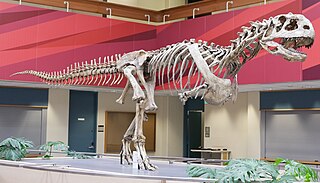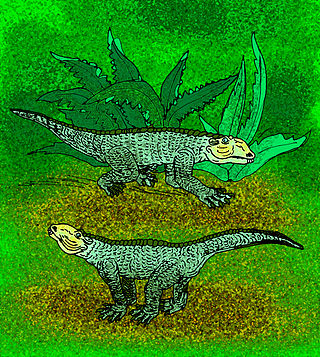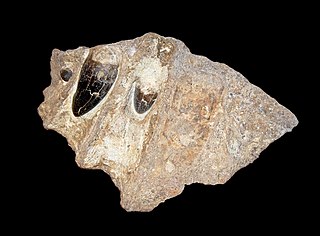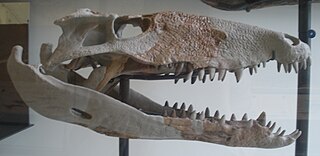
Abelisauroidea is a diverse superfamily of ceratosaurian dinosaurs, typically regarded as a Cretaceous group, though the earliest abelisaurid remains are known from the Middle Jurassic of Argentina and possibly Madagascar. Possible Abelisauridae remains were also discovered in Late Jurassic Tendaguru Beds in Tanzania.

Simosuchus is an extinct genus of notosuchian crocodyliforms from the Late Cretaceous of Madagascar. It is named for its unusually short skull. Fully grown individuals were about 0.75 metres (2.5 ft) in length. The type species is Simosuchus clarki, found from the Maevarano Formation in Mahajanga Province, although one isolated multicuspid tooth of this genus was discovered in Kallamedu Formation of India.

Chimaerasuchidae is a family of mesoeucrocodylians. It was erected as a clade in 2004 by Carvalho et al and included Chimaerasuchus from the Early Cretaceous of China and possibly also Simosuchus from the Late Cretaceous of Madagascar. The validity of the clade has been questioned in later studies that found the two genera to be more distantly related.

Mariliasuchus is an extinct genus of Late Cretaceous notosuchian crocodyliforms found near Marilia, Brazil. The first bone remains were found and collected in 1995 by Brazilian paleontologist William Nava, in red rocks from the fossiliferous Adamantina Formation. Four years later, it was described as Mariliasuchus amarali, by Brazilian paleontologists Ismar de Souza Carvalho and Reinaldo J. Bertini.

Razanandrongobe is a genus of carnivorous ziphosuchian crocodyliform from the Middle Jurassic of Madagascar. It contains the type and only species Razanandrongobe sakalavae, named in 2004 by Simone Maganuco and colleagues based on isolated bones found in 2003. The remains, which included a fragment of maxilla and teeth, originated from the Bathonian-aged Sakaraha Formation of Mahajanga, Madagascar. While they clearly belonged to a member of the Archosauria, Maganuco and colleagues refrained from assigning the genus to a specific group because the fragmentary remains resembled lineages among both the theropod dinosaurs and crocodylomorphs.
Malawisuchus is an extinct genus of notosuchian mesoeucrocodylian from the Early Cretaceous Dinosaur Beds of Malawi. It was described in 1997 by Elizabeth Gomani as a member of the family Notosuchidae. The type species is M. mwakasyungutiensis, referring to Mwakasyunguti, the area of northern Malawi where it was found. It was classified as a member of the family Itasuchidae by Carvalho and colleagues in 2004.

Notosuchia is a suborder of primarily Gondwanan mesoeucrocodylian crocodylomorphs that lived during the Jurassic and Cretaceous. Some phylogenies recover Sebecosuchia as a clade within Notosuchia, others as a sister group ; if Sebecosuchia is included within Notosuchia its existence is pushed into the Middle Miocene, about 11 million years ago. Fossils have been found from South America, Africa, Asia, and Europe. Notosuchia was a clade of terrestrial crocodilians that evolved a range of feeding behaviours, including herbivory (Chimaerasuchus), omnivory (Simosuchus), and terrestrial hypercarnivory (Baurusuchus). It included many members with highly derived traits unusual for crocodylomorphs, including mammal-like teeth, flexible bands of shield-like body armor similar to those of armadillos (Armadillosuchus), and possibly fleshy cheeks and pig-like snouts (Notosuchus). The suborder was first named in 1971 by Zulma Gasparini and has since undergone many phylogenetic revisions.

Baurusuchidae is a Gondwanan family of mesoeucrocodylians that lived during the Late Cretaceous. It is a group of terrestrial hypercarnivorous crocodilians from South America and possibly Pakistan. Baurusuchidae has been, in accordance with the PhyloCode, officially defined as the least inclusive clade containing Cynodontosuchus rothi, Pissarrachampsa sera, and Baurusuchus pachecoi. Baurusuchids have been placed in the suborder Baurusuchia, and two subfamilies have been proposed: Baurusuchinae and Pissarrachampsinae.

Sphagesaurus is an extinct genus of sphagesaurid notosuchian crocodylomorph from the Late Cretaceous of southwest São Paulo, southern Brazil.
Trematochampsidae is an extinct family of mesoeucrocodylian crocodyliforms. Fossils are present from Madagascar, Morocco, Niger, Argentina, and Brazil. Possible trematochampsids have been found from Spain and France, but classification past the family level is indeterminant. The trematochampsids first appeared during the Barremian stage of the Early Cretaceous and became extinct during the late Maastrichtian stage of the Late Cretaceous.

Armadillosuchus is an extinct genus of sphagesaurid crocodylomorph. It was described in February 2009 from the late Campanian to early Maastrichtian Adamantina Formation of the Bauru Basin in Brazil, dating to approximately 70 Ma. Armadillosuchus was among the larger and more robust sphagesaurids, with a total length of approximately 2 metres (6.6 ft).
Candidodon is an extinct genus of notosuchian mesoeucrocodylian. Fossils have been found in the Early Cretaceous Itapecuru Formation in Brazil.
Shartegosuchidae is an extinct family of Late Jurassic and Early Cretaceous crocodyliforms. The family is named after the Late Jurassic Shar Teeg Beds in southwestern Mongolia, from which most shartegosuchid remains have been found. Five genera are currently assigned to Shartegosuchidae: Shartegosuchus, Nominosuchus, Kyasuchus, Adzhosuchus, and Fruitachampsa. Shartegosuchus, Nominosuchus, and Adzhosuchus all come from Shar Teeg, while Kyasuchus is known from the Early Cretaceous of Russia. Fruitachampsa is known from the Late Jurassic Morrison Formation of the western United States.

Morrinhosuchus is an extinct genus of notosuchian crocodyliform from the Late Cretaceous Adamantina Formation of Brazil. It is known from a mandible and a portion of the front of the skull collected from the municipality of Monte Alto in São Paulo state. Morrinhosuchus refers to Morrinho de Santa Luzia, a hill nearby the collection site of the holotype, while luziae refers to the chapel of Santa Luzia, which is located on top of the hill.

Sebecia is an extinct clade of mesoeucrocodylian crocodyliforms that includes peirosaurids and sebecids. It was first constructed in 2007 to include Hamadasuchus, Peirosauridae, and Sebecus. It was initially considered to be the sister taxon of the clade Neosuchia, which includes living crocodilians, although some later studies have placed it within Neosuchia as a basal clade. Sebecians were terrestrial crocodyliforms characterized by their deep snouts and ziphodont dentition. They first appeared in the Late Cretaceous, survived the Cretaceous–Paleogene extinction event, and became extinct in the Miocene epoch.
Sebecosuchia is an extinct group of mesoeucrocodylian crocodyliforms that includes the families Sebecidae and Baurusuchidae. The group was long thought to have first appeared in the Late Cretaceous with the baurusuchids and become extinct in the Miocene with the last sebecids, but Razanandrongobe pushes the origin of Sebecosuchia to the Middle Jurassic. Fossils have been found primarily from South America but have also been found in Europe, North Africa, Madagascar, and the Indian subcontinent.

Caipirasuchus is an extinct genus of sphagesaurid notosuchians known from the Late Cretaceous of northern São Paulo State, southeastern Brazil. The type species, C. paulistanus, was named in 2011. A second species, C. montealtensis, was referred to Caipirasuchus in 2013 after having been named in 2008 as a species of Sphagesaurus. A third species, C. stenognathus, was described in 2014. A fourth species, C. mineirus, was described in 2018. A fifth species, C. attenboroughi, was named in 2021 in honour of David Attenborough.

Thanos is a genus of carnivorous brachyrostran abelisaurid dinosaur that lived in Brazil during the Santonian stage of the late Cretaceous Period. It contains only a single species known as T. simonattoi.
Aphaurosuchus is an extinct genus of baurusuchid mesoeucrocodylian known from the Late Cretaceous Bauru Basin of São Paulo, southern Brazil. It contains two species, Aphaurosuchus escharafacies and Aphaurosuchus kaiju.
Titanochampsa is a genus of large mesoeucrocodylian from the Maastrichtian Marilia Formation of Brazil. Although only known from a single skull roof, the material shows that Titanochampsa was not a member of Notosuchia, which were previously believed to have been the only crocodyliforms present in the strata of the Bauru Group. Body size estimates vary greatly and range between 2.98–5.88 m due to the incomplete nature of the holotype fossil. The overall anatomy of the skull roof, alongside its size and possible affinities with Neosuchians, may suggest that it was a semi-aquatic ambush hunter similar to modern crocodilians.













